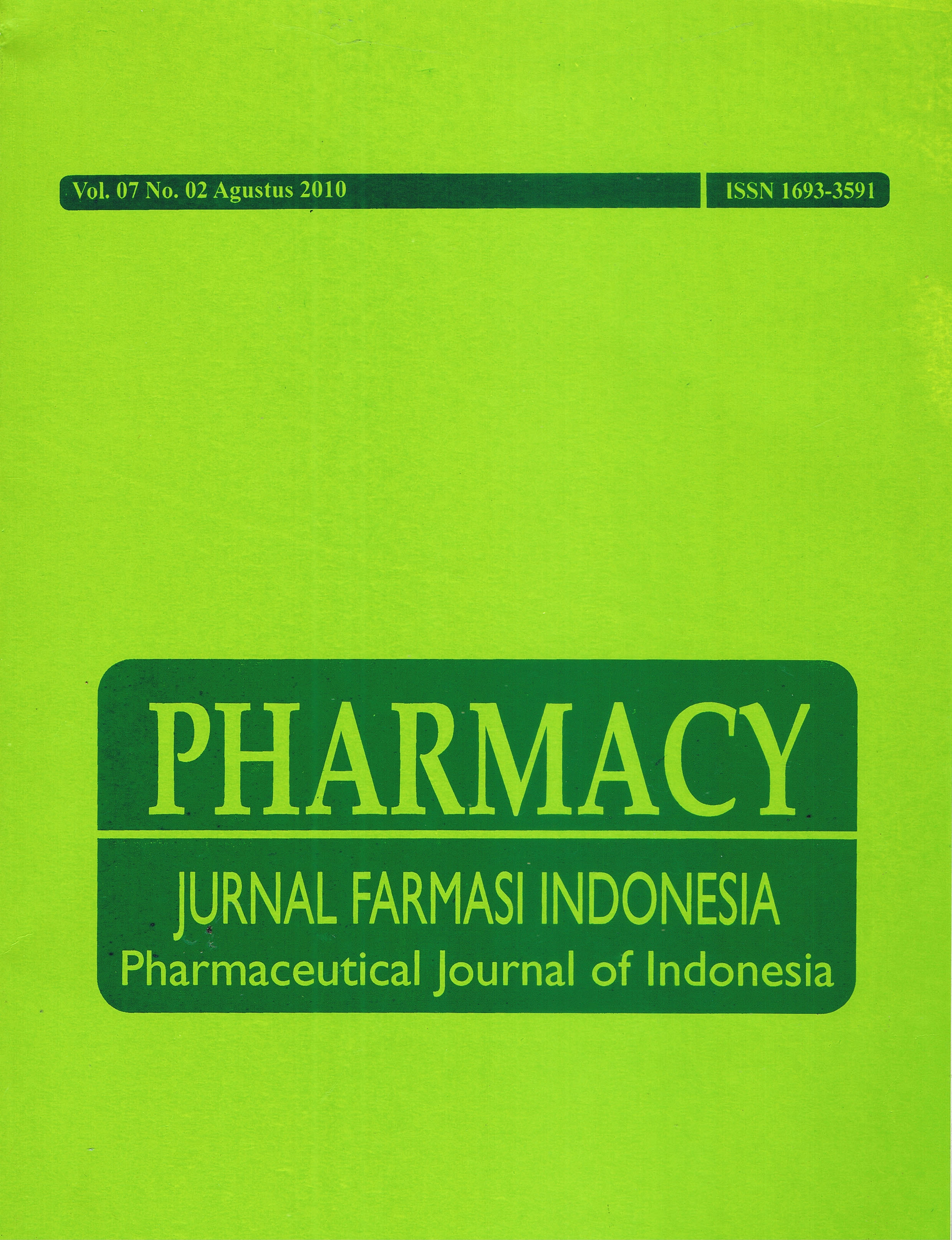DAYA REPELAN GEL MINYAK ATSIRI BUNGA KENANGA (Cananga odorata (Lmk) Hook.f & Thoms) DALAM BASIS CARBOPOL, TERHADAP NYAMUK Aedes aegypti
DOI:
https://doi.org/10.30595/pji.v7i3.574Abstract
ABSTRAK Tujuan penelitian ini adalah untuk mengetahui pengaruh konsentrasi carbopol terhadap sifat fisik gel dan daya repelan gel minyak atsiri bunga kenanga. Minyak atsiri bunga kenanga diperoleh dengan cara penyulingan uap air. Dibuat tiga formula gel minyak atsiri bunga kenanga dengan konsentrasi carbopol yang berbeda (0,5 g, 1,0 g dan 1,5 g). Gel yang dihasilkan dievaluasi sifat fisiknya meliputi uji pH, viskositas, homogenitas, daya sebar, daya lekat dan identifikasi minyak atsiri bunga kenanga. Uji daya repelan dilakukan dengan memasukkan tangan naracoba ke dalam sangkar dengan interval waktu diluar sangkar nyamuk selama 5 menit. Ada lima kelompok yang diujikan, meliputi tangan tanpa intervensi, kontrol negatif berupa tiga formula gel tanpa minyak atsiri bunga kenanga, minyak atsiri bunga kenanga, tiga formula gel minyak atsiri bunga kenanga dan kontrol positif berupa lotion merk “X”. Hasil penelitian menunjukkan bahwa konsentrasi carbopol berbanding terbalik dengan nilai pH dan daya sebar tetapi berbanding lurus dengan daya lekat dan viskositas gel minyak atsiri bunga kenanga. Daya repelan gel minyak atsiri bunga kenanga berbanding lurus dengan konsentrasi carbopol. Kata kunci: daya repelan gel, minyak atsiri bunga kenanga (Cananga odorata (Lmk) Hook.f & Thoms), carbopol, Aedes aegypti ABSTRACT The aim of this research is to know the influence of carbopol concentration to physical characteristic and repellency of cananga flowers volatile oil in carbopol gel base. Cananga flowers volatile oil was extracted by steam water destilation. Three formulas of gel were made by various carbopol concentration (0,5 g, 1,0 g and 1,5 g). The gels produced were tested physical characteristic (organoleptic, pH, viscosity, homogeneity, spread ability, adhesive ability and identification of cananga flowers volatile oil). Repellency was done by entering hand of person into the cage contain mosquitoes with interval five minute. This research used five groups. They were untreated hand, negative control with three formulas of gel did not used cananga flowers volatile oil, cananga flowers volatile oil, three formulas of gel contain cananga flowers volatile oil and lotion merk “X” as positive control. The result showed that the greater carbopol consentration, the smaller in pH and spread ability but the greater in adhesive ability, viscosity and repellency of gel from cananga flowers volatile oil. Key words: repellency of gel, cananga (Cananga odorata (Lmk) Hook.f & Thoms) flowers volatile oil, carbopol, Aedes aegyptiReferences
Afidah N. 2008. Formulasi Gel Kompleks Inklusi Meloksikam Î’-Siklodekstrin Dengan Basis Aqupec HV 505 [skripsi]. Purwokerto: Fakultas Farmasi Universitas Muhammadiyah Purwokerto. Hlm 17-18
[Balittro] Balai Penelitian Obat dan Rempah. 1998. Laporan Penelitian Penanganan dan Penyulingan Bunga Ylang-ylang. Bogor: Balittro. Hlm 2-3
Depkes RI. 1987. Analisis Obat Tradisional. Jilid I. Jakarta: Departemen Kesehatan Republik Indonesia. Hlm 72-74
Fajriyah U. 2009. Formulasi Losion Ekstrak Herba Tali Putri (Cuscuta australis R. Br.) dan Aktivitas Antioksidan Secara In Vitro [skripsi]. Purwokerto: Fakultas Farmasi Universitas Muhammadiyah Purwokerto. Hlm 20-26
Garg A, et al. 2002. Spreading of Semisolid Formulotion: An Update. Pharmaceutical Tecnology: 84-102. http://www.pharmtech.com. [22 September 2009]. Hlm 84-102
Jufri M, et al. 2006. Uji Stabilitas Sediaan Mikroemulsi Menggunakan Hidrolisa Pati (DE 35-40) sebagai Stabilizer. Majalah Ilmu Kefarmasian 03 (01): 8-21
Kardinan A. 2007. Potensi selasih sebagai repellent terhadap nyamuk Aedes aegypti. Jurnal Littri 13 (02): 39-42
Oktaviani WN. 2009. Uji Daya Tolak Nyamuk Kenanga terhadap Hinggapan Nyamuk Aedes aegypti [abstrak]. Semarang: Fakultas Kedokteran Universitas Islam Sultan Agung
Sugito R. 1990. Aspek Entomologi Demam Berdarah. Di dalam: Haryanto B, Harun SR, Wahyadi S, Djaja I, editor. Berbagai Aspek Demam Berdarah Dengue dan Penanggulangannya. Depok. Hlm 37-47
Yuliani HS. 2005. Formulasi Gel Repelan Minyak Atsiri Tanaman Akar Wangi (Vetivera zizanioidesi (L) Nogh): Optimasi Komposisi Carbopol 3%.b/v.–Propilenglikol. Majalah Farmasi Indonesia 16 (04): 197-203. [22 September 2010]. Hlm 198-199
Yulianto RH. 2006. Perbandingan Efektivitas Repelan Ekstrak Kenanga (Canangium odoratum Baill) dan DEET (N,N-diethyl-m-toluamide) dalam Bentuk Cair terhadap Nyamuk Aedes aegypti [skripsi]. Yogyakarta: Fakultas Kedokteran Universitas Gajah Mada. Hlm 35-37
Downloads
Published
How to Cite
Issue
Section
License
Authors who publish with this journal agree to the following terms:
- Authors retain copyright and grant the journal right of first publication with the work simultaneously licensed under a Creative Commons Attribution 4.0 International License that allows others to share the work with an acknowledgement of the work's authorship and initial publication in this journal.
- Authors are able to enter into separate, additional contractual arrangements for the non-exclusive distribution of the journal's published version of the work (e.g., post it to an institutional repository or publish it in a book), with an acknowledgement of its initial publication in this journal.
- Authors are permitted and encouraged to post their work online (e.g., in institutional repositories or on their website) prior to and during the submission process, as it can lead to productive exchanges, as well as earlier and greater citation of published work (See The Effect of Open Access).






